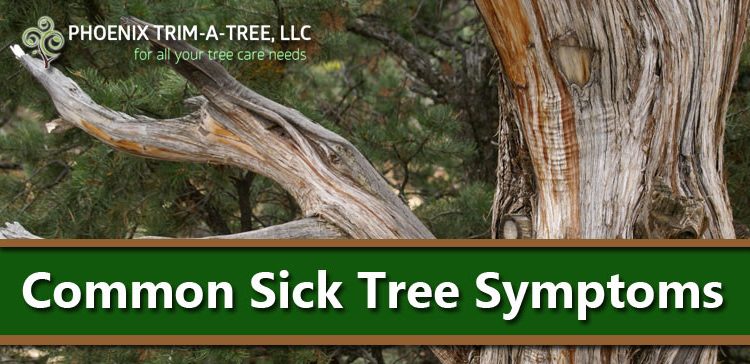Common Sick Tree Symptoms
COMMON SICK TREE SYMPTOMS
GET A FREE ESTIMATE TODAY!
If you are searching for “Sick Tree Symptoms” or “dying tree symptoms“ to judge if your tree is sick or dying, you have come to the right place. Phoenix Trim A Tree put together a detailed list of the most common sick tree symptoms. Please keep in mind, if you have a sick or dying tree in Phoenix, Tempe, Mesa or anywhere else in the Phoenix Valley, Phoenix Trim A Tree’s certified Arborists can help! We can either treat the tree to help it recover or remove it from your property safely and affordably.
6 MOST COMMON SICK TREE SYMPTOMS
A decaying tree is not only dangerous; it can be really unsightly. Falling limbs may cause expensive damage to landscaping and structures. During windy or stormy weather, a toppled tree may crash through your home and cause death or injury. In order to prevent these issues, a home owner should inspect their property’s trees carefully for signs of a dying or sick tree. Look for symptoms that dead tree removal experts recommend like issues with the bark, roots, branches, leaves and trunk.
1. LEAF SYMPTOMS
The first symptom that a home owner will notice about a sick tree is excessive dropping leaves. There are some deciduous and conifers that will drop needles and leaves according to their natural season cycle. But, a tree that begins to lose most of its leaves suddenly in summer or spring is more likely to be sick. Leaves that are still attached but are shriveled and discolored before fall, is another sign that your tree is sick.
2. BRANCH SYMPTOMS
As well as falling leaves, falling branches are a sign that you may have a dying tree. While a storm may snap branches off a healthy tree, a sick tree will begin to drop bare, leafless branches. When you look at the branch closer, you will notice either insect damage or rot.
3. TRUNK SYMPTOMS
That owl hole that is often shown in tree drawings by children, is actually a really bad sign for your trees health. Inspect your trees for any rot out spaces near the base of the trunk for any other sickness indicators.
4. BARK SYMPTOMS
While a healthy tree will have a pliable, soft bark that has even coverage on the trunks surface, a sick tree will have brittle, flaking bark. Often times there may be bald spots on the sick trees as well. Cracking bark and bald spots on your tree are clear signs of sick of dying trees.
5. ROOT SYMPTOMS
If your trees roots are constantly damages by heavy vehicles, lawnmower cuts, or is constantly waterlogged, then the whole tree may be at risk. Look for signs of sogginess like wood ears or fungus. It is vital that you know and locate various signs of tree sickness, in order to prevent your tree from dying and causing damage to your property.
6. FUNGUS & MUSHROOMS
Mushrooms or fungus growing out of the bark on your tree is a bad sign. When bark is soft and not healthy it gives a place for fungus and mushrooms to grow. If you’ve seen any signs of this on a tree you own you should call for immediate service. With the right care some trees can be saved. For those that cannot our safe tree removal services help safeguard your home and property.
HOW TO LOOK FOR SYMPTOMS
Whether you go and look for symptoms of a sick of dying tree or you have one of our tree care professionals, these are the symptoms to check for. Each of these is indicative of a dying tree or a tree that’s got a disease.
CHECK THE LEAVES
If it isn’t fall and your leaves are falling off fast, or they are dropping large amounts of leaves and that is more than normal, then your tree may be sick. If the leaves are not dropping at all, but they are shriveled up and discolored, that is also a sign that you have sick tree.
EXAMINE BRANCHES
If the branches are falling off, that is a sign that you have a sick tree. Yes, strong storms and winds could knock them off, but a sick tree will drop branches more than usual. They normally will not have leaves when they drop. If you look at the branches closely, you will find that there may be insect damage or tree rot, which explains why your tree is sick.
LOOK AT THE TRUNK
You certainly do not want any dents or holes in the tree trunk. Even though they may make a cozy home for your forest friends, they are a sign that your tree is dying.
CHECK THE BARK
Healthy trees will have healthy bark. Healthy bark is normally soft and flexible. A sick tree will have scratchy, brittle, bark that may fall off. There may also be bald spots which are signs of a sick tree.
CHECK THE ROOTS
There are a lot of things that could hurt your tree roots, from children’s toys, to lawnmowers, to water. If the roots become damaged, then your whole tree is in danger. Check to ensure that your roots are not flooded or scratched in any way.
YOU MAY REQUIRE TREE REMOVAL SERVICES
If all of these symptoms check out, then your tree may not be sick. It doesn’t hurt to get a professional opinion whenever you are dealing with a tree that could be dangerous if it dies and falls over. If you think your tree is dead or you would just rather it be removed from your property in the Phoenix, Arizona Metropolitan Area, check out our tree removal page.

